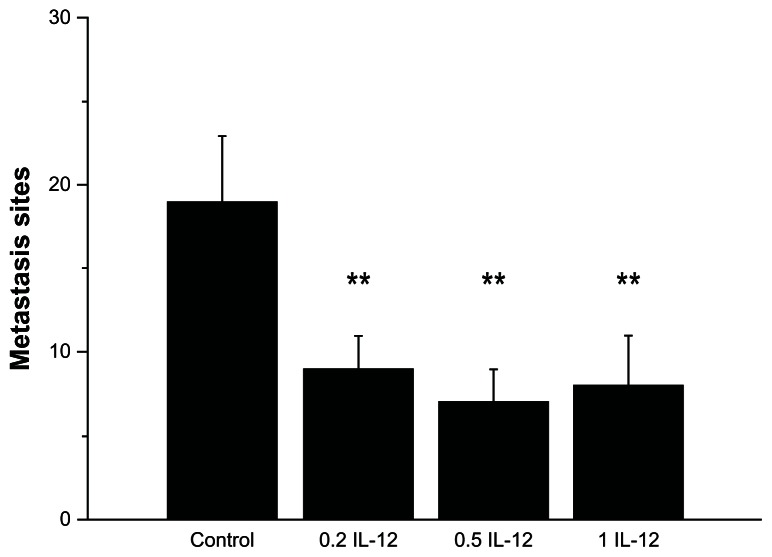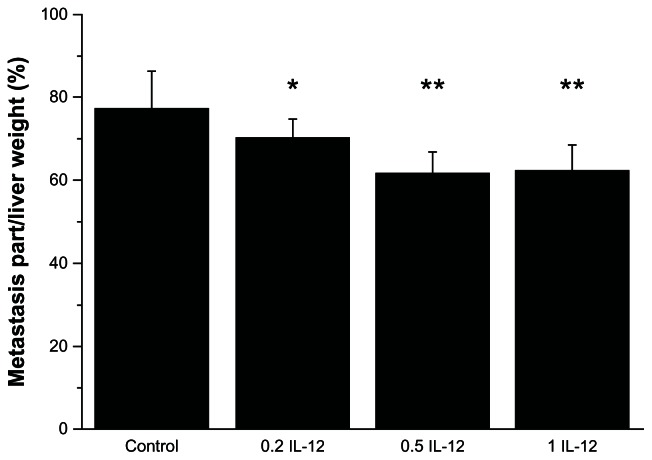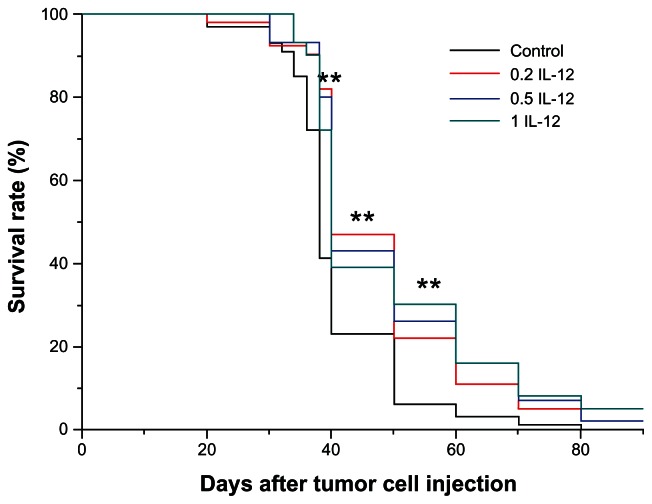Abstract
Interleukin (IL)-12 has emerged to be a prospective molecule for antitumor therapies with many types of cancers. Here we examine the effect of IL-12 treatment in preventing the colorectal cancer liver metastasis in a mice model. At different doses, we found that IL-12 treatment decreased the formation of liver metastasis sites and the percentage of metastasis volume in the liver. Additionally, this treatment leads to improved survival function of mice after tumor cell transplantation. We believe that IL-12 based therapy provided a novel treatment to colorectal cancer patients suffering from liver metastasis.
Keywords: IL-12, liver metastasis, colorectal cancer, therapy
Introduction
Colorectal cancer has been one of the leading causes of mortality by cancer in recent years.1–4 Liver metastases are common for colon cancer patients even after surgery, with poor prognosis.4–7 The treatments for existing liver metastasis or prevention of in vivo cancer metastasis are therefore important to improve the life quality and survival of these patients.
Interleukin (IL)-12 has emerged to be a prospective molecule for antitumor therapies.8–11 IL-12 showed its effects in antagonizing or negatively modulating different types of cancers, as diagnosing factors;10–14 while its potential in treating the colorectal cancer liver metastasis has not been fully explored.8,15–17 In the present study we investigated the possibility of IL-12 based treatment to the colorectal cancer liver metastasis in a mice model.
Materials and methods
Animals
130 Balb/c mice (male, 9–10 weeks) were obtained from and housed in the animal center of Guangzhou Medical College (Guangzhou, People’s Republic of China). This study was approved by the Ethics Committee of Animal Research in Guangzhou Medical College.
Colorectal cancer liver metastasis model
CT-26-murine colorectal adenocarcinoma cells (Shengao Shengwu, Shanghai, People’s Republic of China) were cultured in Dulbecco’s Modified Eagle’s Medium (DMEM) with 10% fetal bovine serum (FBS) (Shenggong Biotech, Shanghai, People’s Republic of China) as previously described in Xu et al,15 at 37°C in 95% O2 and 5% CO2.
The animals were injected with 0.2 mL of 1 × 106 per mL CT26 cells via peritoneal cavity spleen transplant. Every 4 days (starting on the day of transplantation), the mice received 0.9% saline (control group, 20 mice), or 0.2 μg (40 mice), 0.5 μg (35 mice), 1 μg (35 mice) of recombinant murine IL-12 (Sigma and Shenggong Biotech, Shanghai, People’s Republic of China) injection.
Measurements
10 days after treatment, 3 mL blood samples were obtained from the tail vein. The serum was immediately isolated with the centrifuge and the circulating interferon-gamma (IFN-γ) levels were detected by ELISA kits (Shunhe Biotech, Shanghai, People’s Republic of China).15
20 days after the injection of CT26 cells, the animals (10 from each group) were sacrificed and the number of hepatic metastases were counted. The ratio of metastasis volume over the whole liver was calculated.
For other groups of animals, the treatment lasted until the death of the animals (maximum 90 days) for survival rate calculation.
Statistics
The data were represented as mean ± standard deviation (SD), and analyzed with SPSS 16.0 software (SPSS Inc, Chicago, IL, USA). The Student’s t-test was used to compare intergroup differences and P < 0.05 was determined as statistically significant.
Results
IL-12 treatment lead to decreased metastasis
We found that IL-12 treatment decreased the number of liver metastasis sites in the liver as shown in Figure 1. In the control group there were 19 ± 4 sites, while in the 0.2 μg, 0.5 μg or 1 μg IL-12 treatment groups there were 9 ± 2, 8 ± 2, and 7 ± 3 sites respectively (P < 0.01 to control) (Figure 1).
Figure 1.
0.2 μg, 0.5 μg or 1 μg IL-12 treatment decreased the number of metastasis sites in the liver.
Note: **for P < 0.01.
Abbreviation: IL, interleukin.
IL-12 treatment also decreased the percentage of the overall liver with metastasis volume (Figure 2). In the control group the percentage was 77.2% ± 9.2%, while in the 0.2 μg, 0.5 μg or 1 μg IL-12 treatment groups were 70.4% ± 4.3%, 61.9% ± 4.8%, and 62.3% ± 6.4%, respectively (P < 0.05, 0.01 and 0.01 to control).
Figure 2.
0.2 μg, 0.5 μg or 1 μg IL-12 treatment decreased the percentage of metastasis volume in overall liver.
Notes: *for P < 0.05; **for P < 0.01.
Abbreviation: IL, interleukin.
IL-12 treatment increased the survival rate of animals
We found that IL-12 treatment significantly increased the survival time length of the animals (Figure 3). Black: control, Red: 0.2 μg, Blue: 0.5 μg, and Cyan: 1 μg (Figure 3).
Figure 3.
0.2 μg, 0.5 μg or 1 μg IL-12 treatment increased the survival rate of animals.
Note: **shows all three groups were different from the control (P < 0.01).
Abbreviation: IL, interleukin.
IL-12 treatment increased the blood circulating level of IFN-γ
We found that IL-12 treatment significantly increased the circulating IFN-γ level. In control group: 16.2 ± 4.1 μM/LS; 0.2 μg group: 36.1 ± 6.7 μM/LS (P < 0.01); 0.5 μg group: 38.0 ± 2.9 μM/LS (P < 0.01); 1 μg group: 30.3 ± 5.6 μM/LS (P < 0.01).
Discussion
Many colorectal cancer patients demonstrated liver metastasis after the surgery, and contributed to the major cause of death in patients at advanced stages. The management of liver metastasis often includes surgical removal, chemotherapy and other biological treatments. Different types of molecules, such as immunomodulating cytokines, have been adopted to treat liver metastasis.18–21 In the present study we demonstrated that IL-12 treatment could effectively decrease the formation of liver metastasis sites and the percentage of metastasis volume in the liver. Additionally, this treatment leads to improved survival function of mice after tumor cell transplantation.
IL-12 is involved in the differentiation of naïve T cells into Th1 cells, and stimulates the growth and function of T cells. IL-12 also stimulates the production of tumor necrosis factor-alpha (TNF-α) and IFN-γ,8,22,23 which is consistent with our present findings. This might mediate the beneficial effects of IL-12 treatment in preventing liver metastasis as IFN-γ could be anti-angiogenic and block new blood vessel formation through inducible protein-10.22,24,25 These are potential molecules with combined pharmacological effects when targeted together with IL-12.
It should be noted that IL-12 administration could also lead to some side effects and adverse results. Several solutions are possible: (1) combined treatments could be taken to prevent these adverse reactions; (2) controlled release of IL-12 in a slow manner might be of some help;16 (3) targeting the upstream/downstream signaling of IL-12 might lead to more physiological regulation of IFN-γ, yet the therapeutic effects are to be tested.
In conclusion, here we reported that IL-12 administration could be effective for colorectal cancer liver metastasis in a mice model. We expect to see the use of controlled release IL-12 for clinical treatment of colorectal cancer liver metastasis patients in the future.
Acknowledgments
The authors were supported by the Department of General Surgery. The authors were supported by the Guangdong Provincial Science & Technology Project (2009B060700019). All authors designed the study together and performed the experiment together; GZ, WG, LJ and BX analyzed the data and wrote the paper; all authors approved the final manuscript.
Footnotes
Disclosure
The authors report no conflicts of interest in this work.
References
- 1.Jin K, Gao W, Lu Y, et al. Mechanisms regulating colorectal cancer cell metastasis into liver. Oncol Lett. 2012;3:11–15. doi: 10.3892/ol.2011.432. [DOI] [PMC free article] [PubMed] [Google Scholar]
- 2.Tomimaru Y, Sasaki Y, Yamada T, et al. Liver metastasis originating from colorectal cancer with macroscopic portal vein tumor thrombosis: a case report and review of the literature. J Med Case Rep. 2010;4:382. doi: 10.1186/1752-1947-4-382. [DOI] [PMC free article] [PubMed] [Google Scholar]
- 3.Ozturk E, Kilicturgay S, Yilmazlar T, Zorluoglu A, Ozen Y. Factors affecting the prognosis of patients with colorectal liver metastasis. Acta Chir Belg. 2010;110:189–194. doi: 10.1080/00015458.2010.11680595. [DOI] [PubMed] [Google Scholar]
- 4.Kulaylat MN, Gibbs JF. Regional treatment of colorectal liver metastasis. J Surg Oncol. 2010;101:693–698. doi: 10.1002/jso.21503. [DOI] [PubMed] [Google Scholar]
- 5.Nam SJ, Cho JY, Lee HS, et al. Chemotherapy-associated hepatopathy in korean colorectal cancer liver metastasis patients: oxaliplatin-based chemotherapy and sinusoidal injury. Korean J Pathol. 2012;46:22–29. doi: 10.4132/KoreanJPathol.2012.46.1.22. [DOI] [PMC free article] [PubMed] [Google Scholar]
- 6.Zhang Y, Peng Z, Chen M, et al. Elevated neutrophil to lymphocyte ratio might predict poor prognosis for colorectal liver metastasis after percutaneous radiofrequency ablation. Int J Hyperthermia. 2012;28:132–140. doi: 10.3109/02656736.2011.654374. [DOI] [PubMed] [Google Scholar]
- 7.Chirica M, Leconte M, Oberlin O, Dousset B. Surgical treatment of liver metastasis in patients with colorectal cancer. Presse Med. 2012;41:58–67. doi: 10.1016/j.lpm.2011.10.009. [DOI] [PubMed] [Google Scholar]
- 8.Yuzhalin AE, Kutikhin AG. Interleukin-12: clinical usage and molecular markers of cancer susceptibility. Growth Factors. 2012;30:176–191. doi: 10.3109/08977194.2012.678843. [DOI] [PubMed] [Google Scholar]
- 9.Bubenik J. Interleukin 12 in cancer treatment. Folia Biol (Praha) 2011;57:1–2. [PubMed] [Google Scholar]
- 10.Tamandani DM, Shekari M, Suri V. Interleukin-12 gene polymorphism and cervical cancer risk. Am J Clin Oncol. 2009;32:524–528. doi: 10.1097/COC.0b013e318192519a. [DOI] [PubMed] [Google Scholar]
- 11.Nagashima N, Nakayama Y, Inoue Y, et al. Prognostic significance of the local expression of interleukin-12 in patients with advanced gastric cancer. Anticancer Res. 2008;28:1277–1283. [PubMed] [Google Scholar]
- 12.Horinaga M, Harsch KM, Fukuyama R, Heston W, Larchian W. Intravesical interleukin-12 gene therapy in an orthotopic bladder cancer model. Urology. 2005;66:461–466. doi: 10.1016/j.urology.2005.03.052. [DOI] [PubMed] [Google Scholar]
- 13.Nikitina EY, Desai SA, Zhao X, et al. Versatile prostate cancer treatment with inducible caspase and interleukin-12. Cancer Res. 2005;65:4309–4319. doi: 10.1158/0008-5472.CAN-04-3119. [DOI] [PubMed] [Google Scholar]
- 14.Yoshimura C, Nomura S, Kanazawa S, et al. Comparison of interleukin-12 with lung cancer and malignant lymphoma undergoing autologous peripheral blood stem cell transplantation. J Cancer Res. Clin Oncol. 2002;128:29–36. doi: 10.1007/s004320100270. [DOI] [PubMed] [Google Scholar]
- 15.Xu Q, Guo L, Gu X, et al. Prevention of colorectal cancer liver metastasis by exploiting liver immunity via chitosan-TPP/nanoparticles formulated with IL-12. Biomaterials. 2012;33:3909–3918. doi: 10.1016/j.biomaterials.2012.02.014. [DOI] [PubMed] [Google Scholar]
- 16.Hallaj-Nezhadi S, Lotfipour F, Dass C. Nanoparticle-mediated interleukin-12 cancer gene therapy. J Pharm Pharm Sci. 2010;13:472–485. doi: 10.18433/j3630v. [DOI] [PubMed] [Google Scholar]
- 17.Cemazar M, Jarm T, Sersa G. Cancer electrogene therapy with interleukin-12. Curr Gene Ther. 2010;10:300–311. doi: 10.2174/156652310791823425. [DOI] [PubMed] [Google Scholar]
- 18.Eveno C, Pocard M. VEGF levels and the angiogenic potential of the microenvironment can affect surgical strategy for colorectal liver metastasis. Cell Adh Migr. 2012;6:569–573. doi: 10.4161/cam.23247. [DOI] [PMC free article] [PubMed] [Google Scholar]
- 19.Dexiang Z, Li R, Ye W, et al. Outcome of patients with colorectal liver metastasis: analysis of 1,613 consecutive cases. Ann Surg Oncol. 2012;19:2860–2868. doi: 10.1245/s10434-012-2356-9. [DOI] [PubMed] [Google Scholar]
- 20.Maruta M, Maeda K. Trends in the treatment for liver metastasis of colorectal cancer in Japan. Rozhl Chir. 2011;90:669–673. [PubMed] [Google Scholar]
- 21.Valadao M. Reverse approach: a new paradigm in the treatment of synchronous liver metastasis from colorectal cancer. Rev Col Bras Cir. 2010;37:314–315. doi: 10.1590/s0100-69912010000500001. [DOI] [PubMed] [Google Scholar]
- 22.Sangro B, Melero I, Qian C, Prieto J. Gene therapy of cancer based on interleukin 12. Curr Gene Ther. 2005;5:573–581. doi: 10.2174/156652305774964712. [DOI] [PubMed] [Google Scholar]
- 23.Brunda MJ, Gately MK. Interleukin-12: potential role in cancer therapy. Important Adv Oncol. 1995:3–18. [PubMed] [Google Scholar]
- 24.Nakayama Y, Inoue Y, Nagashima N, et al. Relationships between local and systemic expression of interleukin-12 and plasma levels of vascular endothelial growth factor in patients with gastric cancer. Anticancer Res. 2004;24:3289–3294. [PubMed] [Google Scholar]
- 25.Rakhmilevich AL, Hooper AT, Hicklin DJ, Sondel PM. Treatment of experimental breast cancer using interleukin-12 gene therapy combined with anti-vascular endothelial growth factor receptor-2 antibody. Mol Cancer Ther. 2004;3:969–976. [PubMed] [Google Scholar]





